AMD’s GTX 560 Ti Counter-Offensive: Radeon HD 6950 1GB & XFX’s Radeon HD 6870 Black Edition
by Ryan Smith on January 25, 2011 12:20 PM ESTPower, Temperature, & Noise
As was the case with gaming performance, we’ll keep our running commentary thin here. The Radeon HD 6950 1GB is virtually identical to the 2GB card, so other than a few watts power difference (which can easily be explained by being an engineering sample) the two are equals. It’s the XFX Radeon HD 6870 Black Edition that has caught our attention.
| Radeon HD 6800/6900 Series Load Voltage | |||||
| Ref 6870 | XFX 6870 | Ref 6950 2GB | Ref 6950 1GB | ||
| 1.172v | 1.172v | 1.1v | 1.1v | ||
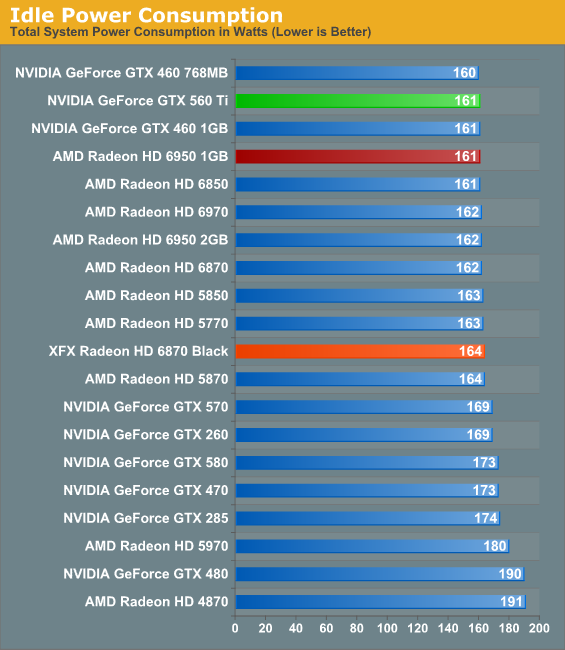

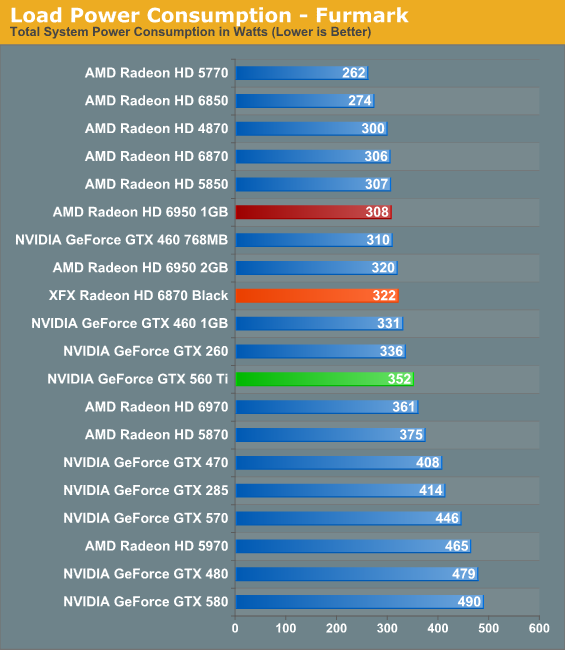
While the XFX 6870 has the same load voltage as the reference 6870, between the change in the cooler and the higher core and memory frequencies power usage still goes up. Under Crysis this is 11W, and under FurMark this expands to 16W. Unfortunately this factory overclock has wiped out much of the 6870’s low power edge versus the 6950, and as a result the two end up being very close. In practice power consumption under load is nearly identical to the GTX 460 1GB, albeit with much better gaming performance.
Meanwhile this is one of the few times we’ll see a difference between the 1GB and 2GB 6950. At idle and under Crysis the two are nearly identical, but under FurMark the 1GB reduces power consumption by some 12W even with PowerTune in effect. We believe that this is due to the higher operating voltage of the 2Gb GDDR5 modules AMD is using on the 2GB card.
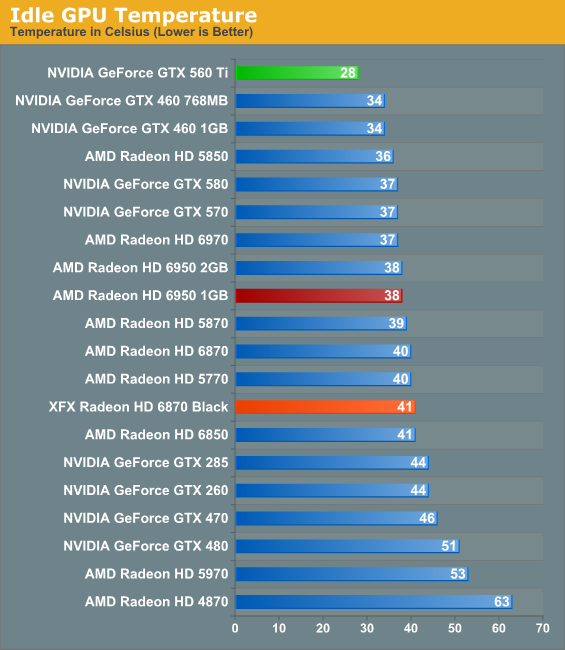


As far as temperatures go both cards are in the middle of the pack. The vapor chamber cooler on the 6900 series already gives it a notable leg up over most cards, including the XFX 6870. At 41C the XFX card is a bit warm at idle, meanwhile 78C under load is normal for most cards of this class. Meanwhile the 6950 1GB and 2GB both perform identically, even with the power consumption difference between the two.
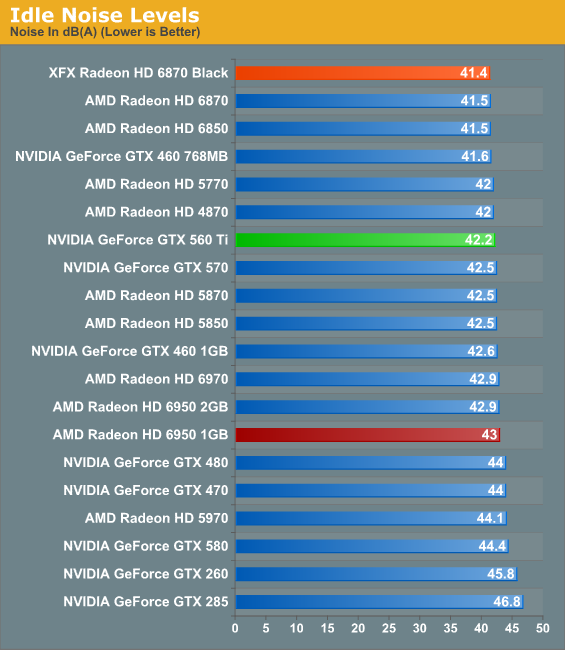
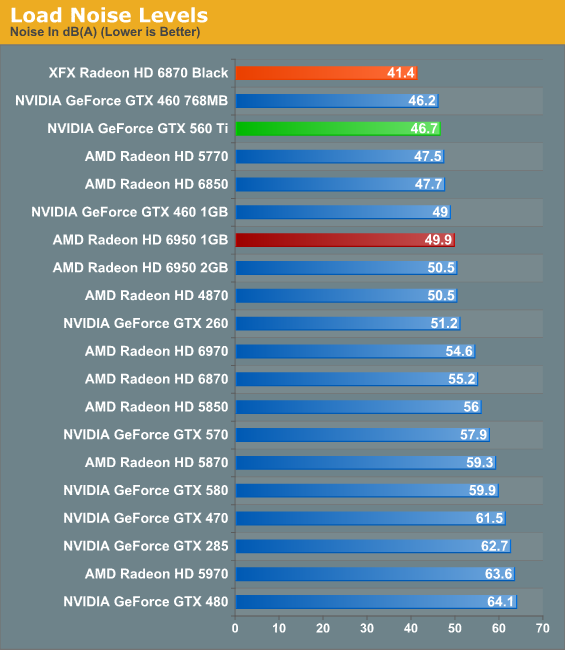
Last but certainly not least we have our noise testing, and this is the point where the XFX 6870 caught our eye. The reference 6870 was an unremarkable card when it came to noise – it didn’t use a particularly advanced cooling design, and coupled with the use of a blower it ended up being louder than a number of cards, including the vapor chamber equipped Radeon HD 6970. The XFX 6870 reverses this fortune and then some due to XFX’s well-designed open-air cooler. At idle it edges out our other cards by a mere 0.1dB, but the real story is at load. And no, that’s not a typo in the load noise chart, the XFX Radeon HD 6870 Black Edition really is that quiet.
In fact at 41.4dB under load, the XFX 6870 is for all intents and purposes a silent card in our GPU testbed. Under load the fans do rev up, but even when doing so the card stays below the noise floor of our testbed. Compared to the reference 6870 we’re looking at just shy of a 14dB difference between said reference card and the XFX 6870, a feat that is beyond remarkable. With the same warning as we attach to the GTX 460 and GTX 560 – you need adequate case cooling to make an open-air card work – the XFX Radeon HD 6870 Black Edition may very well be the fastest actively cooled quiet card on the market.
Meanwhile for the Radeon HD 6950 1GB and 2GB, we’re once again left with results that are nearly indistinguishable. Under load our 1GB card ended up being .6dB quieter, an imperceptible difference.










111 Comments
View All Comments
Stuka87 - Tuesday, January 25, 2011 - link
Why does every single ATI card get the EXACT same FPS in Civilization 5? Did the company that made it get paid off by nVidia to put a frame cap on ATI cards or what? It makes zero sense that 2 year old ATI cards would get the same FPS as just released ATI cards.So... What gives?
Ryan Smith - Tuesday, January 25, 2011 - link
Under normal circumstances it's CPU limited; apparently at the driver level. Just recently NVIDIA managed to resolve that issue in their drivers, which is why their Civ 5 scores have shot up while AMD's have not.Stuka87 - Wednesday, January 26, 2011 - link
Hmm, interesting.WhatsTheDifference - Wednesday, January 26, 2011 - link
please forgive me, Ryan, as I know this sounds abrasive and a little too off-topic from your response here. but speaking of 'score', what's the absolutely mind-boggling delay with including the 4890. quite frankly, if even one of any performance test over the relevant life of the 285 had not the 285 in it, nvidia would burn this site to the ground right after your nvidia-supporting readers did some leveling of their own. so honestly, for every 2xx series that finds its way into a benchmark, where in the world is ATI's top pick of that generation? site regs have posted about anandtech's nvidia-leaning ways, say, a few times, and this particularly clear evidence rather deserves an explanation - in my opinion. or, my spotty attendance contributed to missing at least one fascinating story.7Enigma - Wednesday, January 26, 2011 - link
4870 has been in most of the tests (see launch article) which can be used as a slightly lower-performing card. Use that as a guide.erple2 - Thursday, January 27, 2011 - link
I agree with 7Enigma - the difference between the 4870 and 4890 are no longer significant enough to warrant inclusion in the comparison. I seem to recall that the performance of the 4890 was between the 4870 (shown) and the nvidia 285 (also shown). Couple that with the relative trouncing 30%+ increase in performance) that the newer cards deliver to the GTX285, plus that the frame rates of the GTX285 isn't that high (+30% of 20 fps is 26 fps, which is still "too slow to make it relevant"), I'm not sure that it becomes relevant anymore.cheese319 - Tuesday, January 25, 2011 - link
It should be easily possible to unlock the card through manually editing the bios to unlock the extra shaders (like what is possible with the 6950 2gb) which is a lot safer for the ram as well.mapesdhs - Tuesday, January 25, 2011 - link
Talk about not being consistent. :\ Here we have a review that
includes an oc'd 6870, yet there was the huge row before about the 460
FTW. Make your minds up guys, either include oc'd cards or don't.
Personally I would definitely like to the see the FTW included since
I'd love to know how it compares to the new 560 Ti, given the FTW often
beats a stock 470. Please add FTW results if you can.
Re those who've commented on certain tests reaching a plateau in some
cases: may I ask, why are you running the i7 at such a low 3.33GHz
speed?? I keep seeing this more and more these days, review articles on
all sorts of sites using i7 CPU speeds well below 4, whereas just about
everyone posting in forums on a wide variety of sites is using speeds
of at least 4. So what gives? Please don't use less than 4, otherwise
it's far too easy for some tests to become CPU-bound. You're reviewing
gfx cards afterall, so surely one would want any CPU bottleneck to be
as low as possible?
Any 920 should be able to reach 4+ with ease. And besides, who on earth
would buy a costly Rampage II Extreme and then only run the CPU at
3.33? Heck, my mbd cost 70% less than a R/II/Extreme yet it would easily
outperform your review setup for these tests (I use an i7 870 @ 4270).
For a large collection of benchmark results, Google "SGI Ian", click
the first result, follow the "SGI Tech Advice" link and then select, "PC
Benchmarks, Advice and Information" (pity one can't post URLs here now,
but I understand the rational re spam).
Lastly, it's sad to admit but I agree with the poster who commented on
the use of 1920x1200 res. The 1080 height is horrible for general use,
but the industry has blatantly moved away from producing displays with
1200 height. I wanted to buy a 1920x1200 display but it was damn hard
to find companies selling any models at this res at all, never mind
models which were actually worth buying (I bought an HP LP2475W HIPS
24" in the end). So I'm curious, what model of display are you using
for the tests? (the hw summary doesn't say, indeed your reviews never
say what display is being used - please do!). Kinda seems like you're
still able to find 1200-height screens, so if you've any info on
recommended models I'm sure readers would be interested to know.
Thanks!!
Ian.
Ryan Smith - Tuesday, January 25, 2011 - link
Our 920 is a C0/C1 model, not D0. D0s can indeed hit near 4GHz quite regularly, but for our 920 that is not the case. As for our motherboard, it was chosen first for benchmark purposes - the R2E has some features like OC Profiles that are extremely useful for this line of work.As for the monitor we're using, it's a Samsung 305T.
mapesdhs - Wednesday, January 26, 2011 - link
Ryan writes:
> Our 920 is a C0/C1 model, not D0. D0s can indeed hit near 4GHz quite
> regularly, but for our 920 that is not the case. ...
Oh!! Time to upgrade. ;) Stick in a 950, should work much better. My point
still stands though, some tests could easily be CPU-bottlenecking when
things get tough.
> As for our motherboard, it was chosen first for benchmark purposes - the
> R2E has some features like OC Profiles that are extremely useful for this
> line of work.
So does mine. :D No need to spend oodles to have such features. Your's
would of course be better though for 3-way/4-way SLI/CF, but that's a
minority audience IMO.
> As for the monitor we're using, it's a Samsung 305T.
Sweeeet! I see it received good reviews, eg. on the 'trusted' of the
'reviews' dot com.
Hmm, do you know if it supports sync-on-green? Just curious.
Ian.